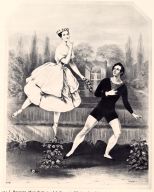 Conclusion
Conclusion
The representations of the dancer, on
stage, in prints and
in text, all conspired
to create an ideal and erotic feminine spectacle. The pointe
shoe was instrumental in this construction of the dancer. Ironically, great
pains and efforts were taken to maintain the illusion of the effortlessness in
pointe work. Despite thephysicality of
this style of dance, the value of pointe work only extended as far as its
ability to appear natural. The
natural grace of a dancer’s techniques allowed her to achieve the
incorporeality that was central to the fetishization of
the female body.Concerns and guilt about
the degradation of the body through this eroticization could be sidestepped
by the locating the dancer in another world, placing
the ballerina at safe distance from her middle-class
counterpart and freeing
her and her body from the social convention of the prosaic world. The pointe
shoe was the site where the danseuse both embraced and denied her physicality:
it was through her physical mastery of pointe work that the dancer affected
her apotheosis in the eyes of the middle-class viewer. In this form, the
ballerina was render safe for middle-class male consumption, allowing her
to embody both ideal ephemeral femininity and erotic, womanly spectacle.
great
pains and efforts were taken to maintain the illusion of the effortlessness in
pointe work. Despite thephysicality of
this style of dance, the value of pointe work only extended as far as its
ability to appear natural. The
natural grace of a dancer’s techniques allowed her to achieve the
incorporeality that was central to the fetishization of
the female body.Concerns and guilt about
the degradation of the body through this eroticization could be sidestepped
by the locating the dancer in another world, placing
the ballerina at safe distance from her middle-class
counterpart and freeing
her and her body from the social convention of the prosaic world. The pointe
shoe was the site where the danseuse both embraced and denied her physicality:
it was through her physical mastery of pointe work that the dancer affected
her apotheosis in the eyes of the middle-class viewer. In this form, the
ballerina was render safe for middle-class male consumption, allowing her
to embody both ideal ephemeral femininity and erotic, womanly spectacle.